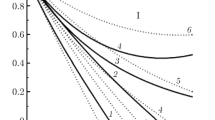Abstract
The problem of fluid motion in renal tubules, in contrast to ordinary flow through cylinders with impermeable walls, is complicated by the existence of radial velocities generated by reabsorption processes. As a first approach to this problem, the Navier Stokes equations for axially symmetric, slow flow in an infinite cylinder whose walls reabsorb fluid are integrated. If the rate of reabsorption is constant, the solutions resemble the conventional Poiseuille flow, i.e., the longitudinal velocity profile is parabolic. In addition the drop in mean pressure is proportional to the mean axial flow, the length of tube between reference points, and inversely proportional to the fourth power of the radius. If the rate of reabsorption is a linear function of the distance from the origin, the presence of an additive term alters these relations. If, for example, the gradient in reabsorption is positive, the axial velocity profile tends to flatten and when the gradient is sufficiently large, the maximum velocity moves from the center of the stream toward the periphery, leaving a relative minimum at the center. In passing from the center of the tube to the walls, the radial velocity passes through a miximum, regardless of the reabsorption properties of the wall.
Similar content being viewed by others
Literature
Burgen, A. S. V. 1956. “A Theoretical Treatment of Glucose Reabsorption in the Kidney.”Can. J. Biochem. & Physiol.,34, 466–474.
Chinard, Francis P. 1955. “Comparative Renal Excretions of Glomerular Substances Following ‘Instataneous’ Injection into a Renal Artery”.Am. J. Physiol.,180, 617–619.
Gomez, Domingo M. 1947. “Hemodynamics of the Renal Circulation”.Rev. Sci.,85, 451–480.
Gottschalk, Carl W., and Margeret Mylle. 1956. “Micropuncture Study of Pressures in Proximal Tubules and Peritubular Capillaries of the Rat Kidney and Their Relation to Ureteral and Renal Venous Pressures”.Am. J. Physiol.,185, 430–439.
Lovatt Evans, Charles. 1956.Starling's Human Physiology. Philadelphia: Lea & Febiger.
Smith, Homer W. 1956.Principles of Renal Physiology. New York: Oxford University Press.
Sommerfeld, Arnold. 1950.Mechanics of Deformable Bodies. New York: Academic Press.
Wesson, Lawrence G., Jr. 1954. “A Theoretical Analysis of Urea Excretion by the Mammalian Kidney.”Am. J. Physiol.,179, 364–371.
Wilde, W. S., and R. L. Malvin. 1958. “Graphical Placement of Transport Segments Along the Nephron from Urine Concentration Pattern Developed with Stop Flow Technique”.Am. J. Physiol.,195, 153–160.
Winton, F. R. 1956. “Pressures and Flows in the Kidney”,Modern Views on the Secretion of Urine. Boston: Little, Brown and Co.
Author information
Authors and Affiliations
Rights and permissions
About this article
Cite this article
Macey, R.I. Pressure flow patterns in a cylinder with reabsorbing walls. Bulletin of Mathematical Biophysics 25, 1–9 (1963). https://doi.org/10.1007/BF02477766
Received:
Issue Date:
DOI: https://doi.org/10.1007/BF02477766




